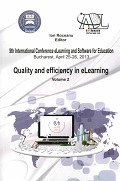PERSONAL AUTHORING AND MEASURING ITS ASSESSMENT IN AN E-TESTING ENVIRONMENT – A CASE STUDY
PERSONAL AUTHORING AND MEASURING ITS ASSESSMENT IN AN E-TESTING ENVIRONMENT – A CASE STUDY
Author(s): Irina Zheliazkova, Adriana Naydenova BorodzhievaSubject(s): Education
Published by: Carol I National Defence University Publishing House
Keywords: Authoring; Measuring; Assessment; E-Testing; Web-Based Teaching Systems
Summary/Abstract: Some earlier researchers in the field of domain-independent web-based teaching systems focused on the process of authoring, tools for its support, and their main requirements (flexibility, adaptivity, sharing, and reusability) are Vassileva, 1995; Murray, 1999; Devidzic, 2001; Aroyo & Dicheva, 2004. As testing is a crucial part of each teaching process to put a web-based teaching system into the real practice to great degree depends on the acceptance of the corresponding testing subsystem by the teachers' community. In this connection measuring the author's personal assessment in e-testing presents of interest from both theoretical and practical points of view. With this aim during the first semester of the current academic year at Ruse University a natural experiment was carried out. Its results are presented and discussed in this paper structured as follows: 1) A detail description of the participants and organization of the experiment, in which the developer of the authoring tool of an e-testing environment was playing the role of an instructor, and master degree students the role of the authors of the e-tests on the lecture course "Intelligent Teaching Environments"; 2) Description of the structure and contents of the test word document, prepared by each student; 3) Short instructions for uploading the test by means of the authoring tool; 4) Raw data including time and collected in an Excel table; 5) Proposed analytical model for the e-test author assessment and its graphical interpretation; 6) Verification of the model computing the correlation with the six-points scale marks, given by the instructor, and 7) Benefits of embedding the proposed model in the authoring tool for etesting.
Journal: Conference proceedings of »eLearning and Software for Education« (eLSE)
- Issue Year: 9/2013
- Issue No: 02
- Page Range: 15-22
- Page Count: 8
- Language: English

